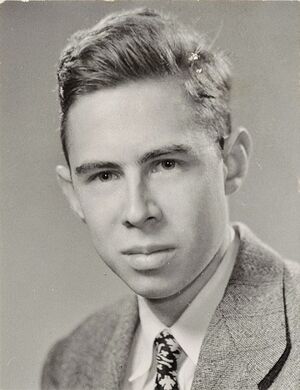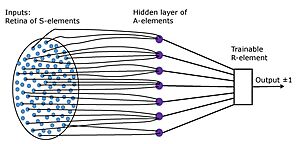Frank Rosenblatt facts for kids
Quick facts for kids
Frank Rosenblatt
|
|
|---|---|

Rosenblatt in 1950
|
|
| Born |
Frank Rosenblatt
July 11, 1928 New Rochelle, New York, U.S.
|
| Died | July 11, 1971 (aged 43) |
| Alma mater | Cornell University |
| Known for | Perceptron |
| Scientific career | |
| Thesis | The k-Coefficient: Design and Trial Application of a New Technique for Multivariate Analysis (1956) |
| Influences | Walter Pitts, Warren Sturgis McCulloch, Donald O. Hebb, Friedrich Hayek, Karl Lashley |
Frank Rosenblatt (born July 11, 1928 – died July 11, 1971) was an American psychologist. He was a very important person in the field of artificial intelligence (AI). Some people call him the "father of deep learning". This is because of his early and important work on artificial neural networks. These networks are computer systems inspired by the human brain.
Contents
Life and Career Highlights
Frank Rosenblatt was born in New Rochelle, New York. His parents were Dr. Frank and Katherine Rosenblatt.
After finishing high school at The Bronx High School of Science in 1946, he went to Cornell University. He earned his first degree there in 1950. Later, he completed his Ph.D. in 1956.
For his Ph.D. project, he built a special computer. It was called the Electronic Profile Analyzing Computer (EPAC). This computer helped him analyze large amounts of data. It could do complex calculations very quickly.
After his studies, he joined the Cornell Aeronautical Laboratory. There, he worked as a research psychologist. He later became the head of the cognitive systems section. This is where he started his groundbreaking work on the perceptron.
In 1960, he helped build the Mark I Perceptron. This was a very early computer that could learn new things. It learned by trying things out and correcting its mistakes. It was one of the first machines to mimic how the human brain learns.
Rosenblatt's interests were very wide-ranging. In 1959, he moved to Cornell's main campus. He became a director and lecturer there. He also joined the section of Neurobiology and Behavior.
Sadly, Frank Rosenblatt died in July 1971. He passed away in a boating accident on his 43rd birthday. This happened in Chesapeake Bay. Many people, including former Senator Eugene McCarthy, spoke highly of him in the House of Representatives.
Key Academic Work
Understanding the Perceptron
Rosenblatt is most famous for creating the Perceptron. This was an electronic device designed to learn like a brain. He first tested his perceptrons using an IBM 704 computer in 1957.
Imagine holding a triangle in front of the perceptron's "eye." The machine would "see" the image. Then, it would send this information through a network of connections. Finally, it would "recognize" the triangle.
He wrote many papers and a book about his ideas. The book was called Principles of Neurodynamics: Perceptrons and the Theory of Brain Mechanisms. It was published in 1962. His work on the Perceptron gained international attention. The New York Times even called it a "revolution."
Rosenblatt proved some important ideas about perceptrons. He showed that simple perceptrons could solve many classification problems. This was true as long as the training data was clear. He also showed that his learning method would work.
Other researchers were also working on similar devices. There was a lot of excitement about what these machines could do. However, in 1969, two scientists, Marvin Minsky and Seymour Papert, published a book called "Perceptrons."
Minsky and Papert looked at simpler perceptrons. They showed that these simpler versions had limits. For example, they couldn't solve problems like recognizing complex shapes. This made some people think perceptrons were not as powerful as first believed.
But Rosenblatt's original work showed that more complex perceptrons were very capable. Later, in the 1980s, interest in neural networks grew again. Researchers looked back at Rosenblatt's work. They found that his ideas were indeed very strong and important.
Today, the Mark I Perceptron is a historical artifact. It is kept at the Smithsonian Institution in Washington D.C.. This machine was able to learn, recognize letters, and solve difficult problems. It is seen as a very early step towards modern artificial intelligence.
Principles of Neurodynamics (1962)
Rosenblatt's book, Principles of Neurodynamics: Perceptrons and the Theory of Brain Mechanisms, came out in 1962. It brought together all his work on perceptrons up to that point.
The neuron model employed is a direct descendant of that originally proposed by McCulloch and Pitts. The basic philosophical approach has been heavily influenced by the theories of Hebb and Hayek and the experimental findings of Lashley. The probabilistic approach is shared with theorists such as Ashby, Uttley, Minsky, MacKay, and von Neumann.
—Frank Rosenblatt, page 5
The book has four main parts. The first part looks at the history of brain models. It also explains the basic ideas of the perceptron. The second part goes into detail about three-layer perceptrons. It covers the math behind them and how they performed in tests. The third part discusses more complex perceptrons. The final part looks at future challenges and ideas.
Rosenblatt used this book to teach a special course at Cornell. Students from both engineering and arts programs took the class.
Rat Brain Experiments
In the late 1960s, Rosenblatt became interested in memory transfer. He was inspired by other scientists who tried to transfer memories between animals. He started his own experiments at Cornell.
He taught rats to do simple tasks, like finding their way through a maze. Then, he took extracts from their brains. He injected these extracts into other rats that had not been trained. He wanted to see if the untrained rats would learn the tasks faster.
Rosenblatt spent his last few years on this research. He showed that the initial reports of big memory transfer effects were not accurate. He found that any memory transfer was very small, if it happened at all.
Other Interests
Astronomy
Frank Rosenblatt also loved astronomy. He even suggested a new way to find planets orbiting other stars. He built an observatory behind his house.
Once it was finished, he started studying SETI (Search for Extraterrestrial Intelligence). This is the search for life beyond Earth. He also worked on ways to detect faint laser signals from space.
Politics
Rosenblatt was very active in liberal politics. He supported Eugene McCarthy's campaigns for president in 1968. He also took part in many protests against the Vietnam War in Washington.
IEEE Frank Rosenblatt Award
The Institute of Electrical and Electronics Engineers (IEEE) is a large group for technology professionals. They give out an award every year called the IEEE Frank Rosenblatt Award. This award honors people who have made important contributions to technology, just like Frank Rosenblatt did.
See also


